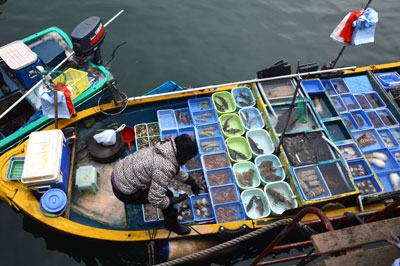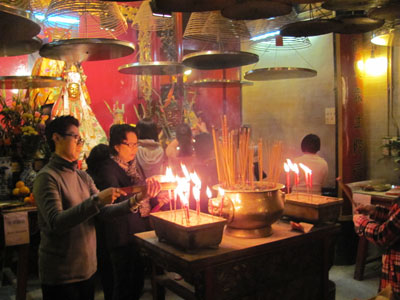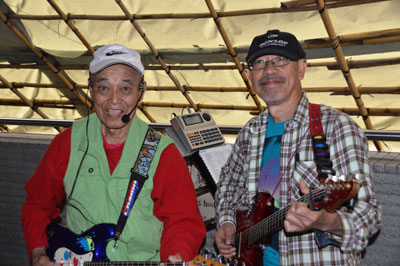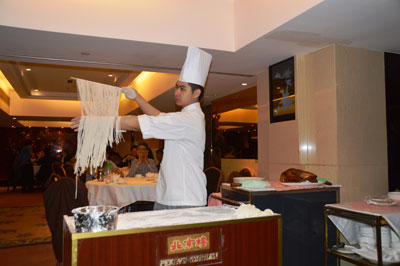Surprising Hong Kong
This article appears on page 6 of the September 2014 issue.
by Steven Cole; Lowell, MI
For years, our good friend Johnny Cheung, a Hong Kong businessman who travels to the US often, urged my wife, Sharon, and me to visit his native city. However, some other destination always seemed to capture our interest more.
But when Johnny visited us in Michigan in September 2013, he announced he’d be retiring soon and possibly moving elsewhere, so if we were ever to visit Hong Kong and have Johnny show us around, the time had come. Within two weeks we’d booked our flight.
First impressions
Our wintertime is the best time to visit Hong Kong, with November and December considered the ideal months for good weather. Unfortunately, our schedules didn’t allow us to travel until after the year-end holidays, and we ended up leaving on Valentine’s Day, 2014.
Landing in Hong Kong, we were glad Johnny was there to meet us because, almost at once, we encountered surprise number one: few native Hong Kongers speak English!
Since Hong Kong had been a British colony for more than 150 years before its return to the Chinese in 1997, we could scarcely believe our ears.
Johnny said that, since the handover, the Beijing government has increasingly stressed that Hong Kong residents, most of whom speak Cantonese, learn Mandarin, the language spoken in Beijing, rather than English. While that would account for young people not being conversant in English, we found just as many older Hong Kong residents who knew little or no English.
Thankfully, for us, signs in public places were in both Chinese and English, and many restaurants, shops and other businesses bore English names.
For most of our 2-week stay we rented an apartment, but for the first two nights we stayed at the Island Pacific Hotel (No. 152 Connaught Road West), where we got separate rooms so that each of us could recover from jet lag at our own pace.
The rooms were beautifully appointed but only big enough for a bed, a small desk and a straight-back chair. I had to use the desktop for a luggage stand. This was our first indication of how space is at a premium in Hong Kong.
Our apartment in the Wan Chai district presented our next surprise: the majority of Hong Kong’s population, even the wealthy, lives in spaces painfully smaller than what the average American is used to.
The one bedroom had only enough room for a down-sized version of a double bed and some built-in drawers. The kitchen had a 2-burner cooktop and only 24 inches of counter space but no space for the refrigerator, which stood in the living/dining room. The bathroom was tiny as well.
Looking out at undraped windows of apartments in nearby buildings revealed that our apartment was typical. Hong Kong is literally crammed with such buildings.
We found the apartment ($85 per day) through Airbnb.com. Neither the landlady nor we were wholly satisfied with the company, largely because of its poor communication.
Shopping
Hong Kong has a worldwide reputation as a mecca for shoppers, and, being a born shopper, I was eager to hit the streets and malls in search of bargains. In so doing, I was met with our next surprise: Hong Kong shopping is mostly of two kinds, glitzy malls with merchandise so expensive that most of us wouldn’t be regular customers and street stalls selling a mishmash of souvenirs, cheap clothes and sundry novelties.
It was incredible how many jewelry stores there were in the Central District. No block was without at least two stores specializing in watches. When I first peered into a window of one jewelry store, I saw a watch with a price tag of US$10,000! Oddly, none of the hundreds of jewelry stores we saw were busy, and many had no customers at all.
Every famous designer’s brand of clothing and accessories has stores seemingly everywhere, and many items were unique. So even if you aren’t flush with money, strolling Central’s many malls — all located in skyscrapers — is tons of fun, as you’ll see all kinds of expensive stuff you’d rarely see, if ever, back home. (One day I was passing a camera store and spotted a Hasselblad in the window for $44,000!)
Don’t expect to find any bargains on photography equipment. Prices are almost identical to those at discount camera stores in the States.
Step onto a side street or into an alley and you’ll find it lined with a whole other world of tiny stalls where, if you sift through the piles of kitsch, you might find a treasure. I stumbled onto an antique Art Deco brass teapot for a mere $30 and a colorful child’s watch for my 3-year-old granddaughter for $3.
Always on the lookout for good folk art, we passed up many a bin of cheap, mass-produced paintings until coming upon some well-executed, one-of-a-kind peasant scenes for a few dollars each.
Hollywood Road is famous for its antique shops, and it provided the most interesting shopping experience, although there was a preponderance of furniture, garden statuary and similar items too large and heavy to carry or ship home.
The backstreets are where to go to buy produce as well, and we sought bananas and other fruit for breakfasts and snacks (we did not cook any meals during our trip). I was surprised at the high quality of the produce and, especially, the artful displays. Asparagus was in season, and vendors had bundles of tiny spears, each precisely identical in diameter and length and perfect in color.
Dining out
Hong Kong has thousands of restaurants, and among the most popular (and offering the best value) are those serving buffets. Johnny took us to one of the best, Café Kool at the Shangri-La Hotel (64 Mody Rd., Tsim Sha Tsui East) in busy Kowloon, across the harbor from the Central District. The huge, upscale space was crammed with diners on a weeknight.
The buffet ($32 per person) offered scores of entrées, including Chinese dishes from China’s various regions, specialties from other Asian countries, a dozen Indian dishes, sushi and a huge selection of fish and seafood plus all manner of Western food, from fried chicken to prime rib. There was also an extensive array of salads and vegetables and a selection of desserts to die for.
On another night we dined on Peking duck at Peking Garden, located in the Star House building in Kowloon. The juicy duck was carved tableside, and slices were eaten by rolling them, along with a sprig of green onion, in small wrappers resembling tortillas. Entrees here cost $13 to $27.
The carcass was taken back to the kitchen, where the remaining tidbits were removed and minced with vegetables before being returned to the table.
The Peking Garden offered some surprising dining room entertainment as well. A chef made perfect noodles merely by stretching and twirling a huge lump of dough that miraculously separated into uniform strands without being cut. The performance was so astonishing that diners clapped loudly when the chef finished.
Unfortunately, the lowest-priced restaurants in Hong Kong usually don’t offer an English menu. Local residents will eat just about any part of a pig, cow or chicken, as well as strange sea creatures, so we stuck to places that catered to tourists and had English menus, thus assuring there would be no surprises on our plates.
Transportation
Getting around to restaurants, shops and sights was surprisingly easy, as Hong Kong has an excellent public transportation system consisting of subways, trams and buses.
Almost everyone buys an Octopus card, a stored-value card that you pass over an electronic sensor for fast access to the transportation of your choice. The card is also accepted for purchases at some supermarkets and convenience stores.
For those under 65, a subway or bus ride to all stops on this far-flung network costs the equivalent of $1.50, but for us senior citizens it was only 25¢!
Subways are preferable because of their speed, but they are terribly crowded and people are constantly pushing and shoving. Stations sprawl for blocks under city streets, and there is no accommodation for those who aren’t in shape for extensive walking. (We saw no accommodations for the handicapped.)
Although stations have escalators at lower levels, none serve the street level. It was three steps up from the sidewalk to the subway entrance and from 32 to 50 steps down (and, of course, later, back up) before we reached the escalators that carried us down deeper to the tracks.
Getting away
After exploring the streets and shops for a few days, we needed a breather from the stifling crowds. What sounded like the best escape was Ocean Park, an amusement park with the usual thrill rides plus many other attractions for both children and adults.
The park is located on a mountaintop. A bus takes visitors to the base of the mountain, then cable cars continue to the top, a ride offering spectacular views of Hong Kong Island’s harbors.
Ocean Park has a small aquarium, bird and butterfly attractions, a pagoda with tanks of unique goldfish and an enclosure with two pandas. Another building houses jellyfish floating in tanks lit by colored lights. There’s also an outdoor pool for daily shows of performing dolphins. Jugglers, acrobats and jazz musicians provide more entertainment.
Entry costs $42 per adult for an all-day pass, a price we considered well worth it.
Another day, we took a tram up to the famous Hong Kong Peak for spectacular views of the Central District’s countless skyscrapers, one of the densest concentrations of tall buildings anywhere in the world.
At the terminus of the Peak Tram, you enter a large building and ascend escalators up several floors crammed with shops (what else?) to a chilly, windswept outdoor viewing deck.
We lunched at Café Deco (118 Peak Rd.) with floor-to-ceiling windows allowing patrons to take in the view. Surprisingly, lunch entrées cost only about $20 — a bargain, considering the setting, the stylish décor and the gourmet food!
Looking to the other side of The Peak, I saw heavily wooded hills and valleys — a startling scene only a couple of miles as the crow flies from the congestion of skyscrapers.
Leaving The Peak terminus building, we saw another big building housing yet another mall with branches of the same high-end retailers found down below in the Central District. Beyond the mall was Pok Fu Lam Country Park, with a paved trail that descends the forested mountainside to a distant reservoir near the west coast of the island. The walk took about two hours and was not strenuous.
Central and Kowloon both have many parks tucked between skyscrapers, but the Pok Fu Lam trail is the closest it gets to true peace and quiet.
From the reservoir, we took a bus to Aberdeen, a city on the water on the opposite side of the island from Central’s skyscrapers, though it has a number of skyscrapers of its own.
Aberdeen’s chief attraction is a noisy floating restaurant called Jumbo Kingdom. One of our best experiences was the free ferry ride to the restaurant; it took us through a pretty harbor jammed with colorful working boats and luxury yachts.
The New Territories
We were also able to explore the New Territories, which includes a surprisingly large chunk of land attached to mainland China. We traveled first by subway, then bus to the end of a road, arriving at the tiny fishing village of Po Toi O. The village was unremarkable, but the uninhabited coastal scenery along the way was beautiful.
Unfortunately, on the day we went to the New Territories it was heavily overcast and rained briefly. During our entire stay, we had only two sunny days in Hong Kong; locals attribute the weather conditions to air pollution from mainland China.
Most days were in the mid-60s. The temperature peaked at 72°F. Having fled the worst winter in decades in Michigan, we enjoyed being able to wear summer shirts and only occasionally needing light jackets.
We never stopped being amused by Hong Kongers bundled in thickly padded parkas and heavy wool coats, with long wool scarves wrapped tightly around their necks up to their chins. We would have been roasting in those clothes!
Far up the east coast of the Sai Kung Peninsula in the New Territories, we stopped at the city of Sai Kung, which surprised us greatly, as it had not one skyscraper and no glitzy malls and it bore the look of a small city in Middle America. For these reasons, Sai Kung is a favorite bedroom community for Westerners living in Hong Kong.
Most surprising of all in Sai Kung was Anthony’s Ranch (28 Yi Chun St.), an Old West-themed restaurant serving American food. We had enormous pulled-pork sandwiches, a little cup of coleslaw, French fries, a salad (or soup), a pickle and a soft drink for $10 each!
Sai Kung has an interesting harbor where fishermen each sell their catch to customers who line the street above water level and pass cash down in a basket to the fishermen in their boats.
The most interesting thing in Sai Kung, however, was the large Tin Hau Temple. Hong Kong has hundreds of temples, where elements of Buddhism, Taoism and Confucianism mix with ancestor worship and ancient beliefs aimed at appeasing all sorts of gods and spirits.
Temple interiors, lit by candles and burning joss sticks, reveal a riot of color in tapestries, statuary, paintings and religious objects, including gongs and drums. Visitors are free to take pictures inside or out, and we never tired of taking photographs of these amazing scenes.
Hong Kong’s Man Mo Temple in the western district is best known to travelers, but Sai Kung’s temple and Pak Tai Temple in the Wan Chai area are far bigger and, I thought, more interesting.
A few last sights
One of the most surprising sights in Central is the 2,600-foot-long, covered outdoor Central-Mid-Levels escalator that ascends the steep mountain behind Hong Kong’s main section of skyscrapers. The escalator serves the residents of the apartment towers at higher levels, taking them down to their jobs in Central in the morning, then taking them back up to their homes after work.
Halfway up the escalator is a prosperous area called the Mid Levels, where you’ll find small trendy shops and many ethnic restaurants.
Before leaving Hong Kong, we had to squeeze in the city’s most popular tourist attraction, a harbor cruise. The hour-long ride simply takes you past more skyscrapers, and we were somewhat disappointed. However, the excellent maritime museum on the Central side of the harbor by the cruise dock made up for it.
On our last night in Hong Kong we dined near the harbor in Kowloon and, afterward, strolled along a promenade with spectacular views of Central’s skyscrapers, many of which were creatively lit with colored, moving lights. It was the only time on the trip when I wished I had a tripod for my camera so I could capture a sharper image of this memorable scene.
Hong Kong, incidentally, is very safe, night or day, and we never felt threatened in even the densest crowds.
Our trip cost $4,000, including airfare from Grand Rapids, MI, accommodations, food, souvenirs and dog boarding. However, we are penny pinchers, plus we enjoyed generous hospitality from our friend Johnny, so others should expect to pay more.





